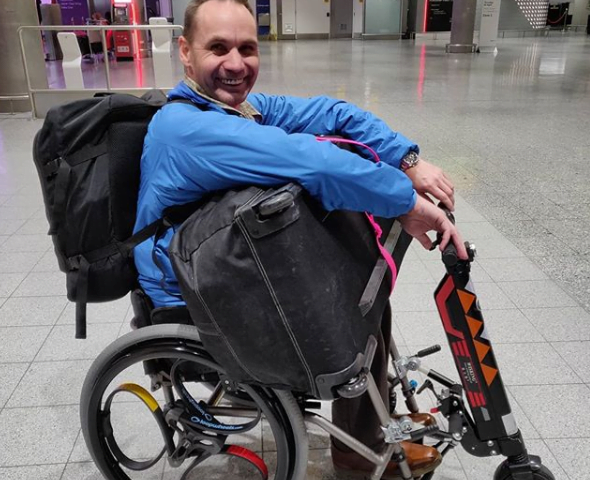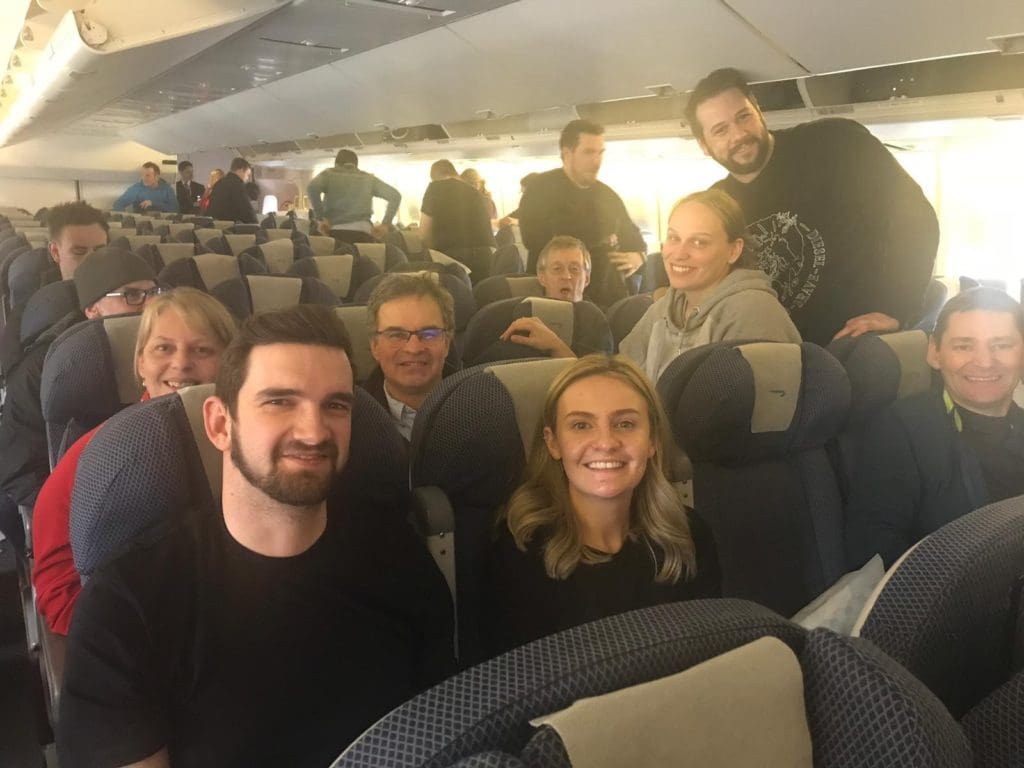Travelling with a spinal cord injury – The Back Up Travel Guide
With a spinal cord injury, you may need to do additional planning to ensure stress-free travel. That’s why we’ve put together the Back Up Travel Guide, a one-stop resource for all your spinal cord injury travel needs!
Planning in advance – from booking your hotel to organising insurance

Kim exploring Death Valley, California
• Sometimes it’s best to use major hotel chains rather than smaller, independent hotels. They are more likely to have accessible rooms.
• Try using websites like Euan’s Guide and user-led Facebook groups to research hotels before you book them. Euan’s Guide rates hotels on their accessibility, and Facebook communities like the “SCI Owner’s Club” are a great way to ask fellow spinal cord injured people questions about their travel experiences.
• As well as rooms, it’s a good idea to assess the rest of the hotel before you arrive. Try to find out where the other accessible toilets are and check the accessibility of the pool or restaurant. It can also be handy to look into the streets surrounding the hotel and enquire about disabled parking or local public transport.
• When booking your stay, always ask to see photos of the bedroom and bathroom. This way you can see for sure if your room will suit your needs. You can also use the photos to check how much space you’ll have on either side of the bed and in the bathroom for easy transfers.
• Make sure that you’ve sorted out travel insurance before you set out.
“I personally buy annual travel insurance with max coverage. It’s important that you declare all of your medical conditions.”
“If you have frequent problems with pressure sores, bladder infections, or any other conditions, consider using a provider specifically aimed at people with existing medical conditions.”
“I make sure to shop around various providers on the internet. It’s good to find a provider that will cater to your specific needs with good value.”
• Before you set off, it’s good to give your mobility aids a mini-service.
“I check that all the nuts and bolts on my wheelchair are fastened tightly. I also check my tires and replace them if needed. To prevent pressure sores, I check the cushion and upholstery are in good condition. If you’re going to be using your chair a lot, it’s important that it’s in top condition.”
• When planning your trip, it’s good to spend some time thinking about how you’re going to access attractions at your destination.
“If I book a tour, I make sure to email the organiser beforehand and let them know I’m a wheelchair user. This will allow them to take this into account and be mindful of the route they are taking.”
“Tour guides are usually very happy to compromise with you if you let them know in advance. For example, a tour in Zagreb once organised for me to go in a funicular to get down a hill, so I didn’t have to chance it with a steep cobbled street!”
Managing your luggage

Jacques, showing off his luggage solution
• Depending on your injury, it’s up to you how you deal with luggage.
“I like to use a rolling luggage bag that I clip onto the back of my wheelchair with a climbing carabiner.”
“I try not to carry more than what I carry myself. I keep a big bag on my lap, and a cabin-size backpack on the back of my chair.”
“I’m a power chair user with personal assistants. My care team help me by carrying my bags.”
• When travelling by car, you can carry more luggage. If you’re flying, then you may need to be more cautious about what you take.
“I keep a change of clothes and a supply of any medication I may need in my hand luggage in case my flight is delayed or my main bag doesn’t arrive at the destination when I do.”
• Your airline should give you free allowance to have an extra bag for medical supplies. Be sure to contact your airline before you fly to confirm this. This allowance should also cover taking along shower chairs and sports chairs.
Looking after your bladder and bowels while travelling
• If travelling long haul, you can increase the drainage capacity of your indwelling catheter by attaching a two-litre leg bag.
• Secure your catheter with a catheter securement strap to stop it being pulled when transferring from your day-to-day chair into the aisle seat.
• Keep a RADAR key on you – this is a scheme that allows disabled people to access locked disabled toilets themselves.
• Use bottled water in places where the tap water is not safe to drink. This can help avoid diarrhoea and vomiting.
• If you are prone to UTIs, talk to your doctor about bringing prophylactic antibiotics with you.
• Remember that your body may take a while to get used to a new routine in a different time zone. You may also be eating different types of food, which can affect your bladder and bowels.
• Empty your bowel the night before flying to prevent needing to use the toilet on the plane.
• Pack spares of any equipment or medication you may need for your bladder and bowel – you never know if something could get lost while travelling.
“If I’m travelling to a hot country, I make sure to pack extra catheters. You’ll be drinking more because of the heat, so you’ll need to use the toilet more often!”
Travelling with personal assistants (PAs)
• Ideally, you should travel with a PA who knows you well. They will know your routine, and can help you stick to it while travelling. If you’ll be travelling with a new PA, organise to meet them for a few days beforehand to get to know them.
• It may seem obvious, but make sure to consider your PAs while booking your stay. You need to consider where they will be staying, and you need to work their food and accommodation into your budget.
• Do you have a plan in place in case of an emergency? Make sure a back-up PA is available back home to come out to you in the event of your PA getting ill.
• Your PA needs to have insurance as well. They may get this through their care agency, but it’s worth checking in advance so you can sort it out if needs be.
• Think about itineraries before you leave:
“When do your PAs get breaks? What are their shift times? I make sure to draft up a rota in a spreadsheet before we head off. That helps me ensure that my PA team isn’t getting overworked.”
Flying with a spinal cord injury

Our Colorado sit ski course participants, ready to jet off!
• Communication is key – This is important to remember at all stages of your flight, from checking in to landing.
“Make sure that you tell staff at check-in that you will be taking your wheelchair to the aircraft, and that you will need it to be at the aircraft door before you get off the plane. Ideally, you should be the first person to board the airline and the last to get off.”
“If you can walk but choose to use a wheelchair, don’t leave the aircraft until you know that your wheelchair is waiting for you!”
• Do not restrict fluids on a flight, even if it seems tempting when you’re worried about bladder management – dehydration is never good.
“If I’m on a long flight and I don’t have anyone on board to help me get to the toilet, I still drink as much as I usually would. I just make sure to avoid diuretics – drinks with caffeine or alcohol that may make you need to urinate.”
• On long haul flights, look after your skin. Tight clothing can cause marks that can lead to pressure sores. Bring a pressure-relieving seat cushion, and wear loose comfortable clothes.
• Check all your mobility aids are in good shape once you’re reunited with them. If there is any damage, report it immediately. Do this while you are at the airport mobility assistance service, so you can get a reference number you can use to claim on your insurance or the airline’s insurance.
“My best advice in relation to flying is ‘just do it’! Worry about things IF they go wrong, because they probably won’t.”
The Queen Elizabeth Foundation have created this useful video guide to flying as a disabled person.
To sum it up…
Overall, our best tip for travelling with a spinal cord injury is to enjoy yourself! You just may need some additional support along the way, and you may need to plan more in advance. This quote from Kim, one of our travel-loving staff members, says it all…
“Since my accident 10 years ago, I’ve managed to fly in a sea plane in Vancouver with help from the pilot, gotten on board trains through Milan with the help of fellow travellers, and gone down the salt mines of Wieliczka with the help of a maintenance crew. I was a bit self-conscious asking for help at first, but I was more worried about missing the experience!”
“Things go wrong with travelling, even without a spinal cord injury. You just need to know when to ask for help, to prepare for the worst-case scenario, and only be disappointed if the worst does happen!”
Useful external links
Lonely Planet’s disabled travel guide
Travel John – A unisex portable urinal
Foreign travel advice from the UK government


